EXPLORING SOME OF THE HIGHLIGHTS OF PUGLIA’S VALLE D’ITRIA
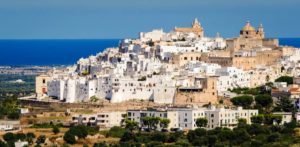
The Valle d’Itria is, for many people, the heart of Puglia. It’s where you’ll see the white rendered trulli houses with their stone conical roofs for which Puglia is famous, along with white-washed villages such as Alberobello and Locorotondo, and larger towns like Martina Franca and Ostuni. The rolling green valley is criss-crossed by dry-stone walls, vineyards, ancient olive and almond groves and winding country lanes. It’s a visitor’s dream location.
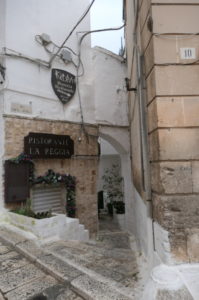
The town of Ostuni, known as the città bianca, the “white city”, is an ideal base from which to venture forth to explore the local area. This lovely town has been built on a hill, which affords great views overlooking the olive trees of the valley and the azure blue sea in the distance. Ostuni’s historic centre has preserved its medieval character, and appears to spiral around the hill on which it’s perched, and still has its ancient fortified walls.
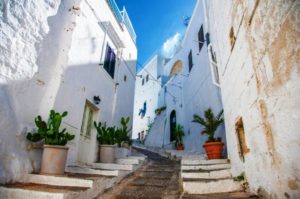
The region around Ostuni has been inhabited since the Stone Age, and the town itself is said to have been established by the Messapii, a pre-classic tribe of Greek origin. It was almost destroyed by Hannibal during the Punic Wars, and later rebuilt by the Romans. The historic centre is a maze of narrow, cobblestone streets, stairs, small courtyards, full of shops and little restaurants. A good place to start exploring the town is from the Piazza Libertà, an elegant square from where you can visit the beautiful Town Hall, which started out life as a convent. Next to it is the church of San Francesco d’Assisi, and on the other side you can admire the 20m high obelisk of San Oronzo, the town’s patron saint.
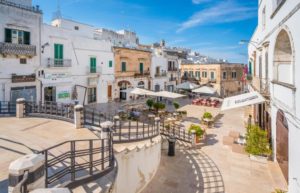
From this piazza, the via Cattedrale snakes it way up to the Cathedral, and this street is full of shops, cafes, delis and restaurants. Cattedrale Santa Maria Assunta has a beautiful façade made up of Gothic, Romanesque and Byzantine elements. Hidden among the pedestrianised area of the old town, visitors will soon discover many more fine churches, restaurants and residential buildings in Romanesque and Byzantine styles. In warmer months, the many brightly coloured bougainvillea plants that seem to be in every nook and crevice across the historic quarter make a wonderful contrast against the dazzling, white walls.
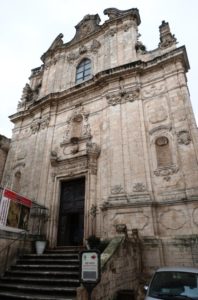
One of the most interesting places to visit in Ostuni is the Museum of Pre-Classic Civilisations of the Southern Murgia, housed in a former Carmelite monastery. There are many fascinating Neolithic and Palaeolithic objects unearthed from local archaeological digs. One very important exhibit is a cast of a skeleton of a woman, that the archaeologists have named Delia, who was pregnant at the time of her death 28,000 years ago, during the Paleolithic Age.
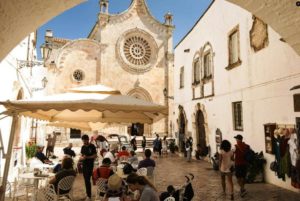
Ostuni is the perfect base to visit the smaller towns and villages of the Valle D’Itria, and of course, the area’s greatest attraction, the famous trulli houses, sometimes also called casiedde (shacks or huts) which are specific to this part of Puglia.

The trulli (trullo in the singular) are limestone huts which are remarkable examples of dry wall, i.e., mortarless, construction, a pre-historic building technique still in use in this region. Generally constructed as temporary field shelters and storehouses as well as permanent dwellings, trulli are made of roughly worked limestone boulders collected from the surrounding fields and during the process of creating sub-floor cisterns.
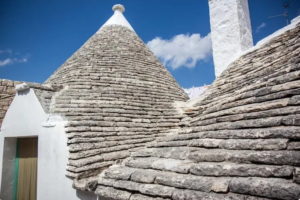
A defining characteristic is that they feature pyramidal, domed or conical roofs built up of corbelled limestone slabs—an overlapping arrangement in which each course diminishes closer inwards than the course below. There are two layers for the walls, to provide insulation. The roof has a gutter system that collects rainwater, and fireplaces and ovens could easily be made within the walls in a way that was safe.
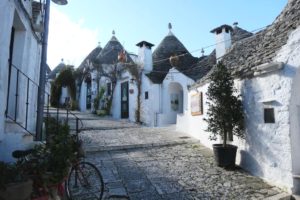
Although trulli can be found all along the Valle d’Itria, their highest concentration and best preserved examples are in the town of Alberobello, where there are over 1,500 of them. The trulli shape likely arrived in Puglia with the Greeks, who colonised the region. Some historians have theorised that trulli are similar in design to early Greek funerary monuments, and given that the Greek word trullos, means cupola or dome, it seems like a credible theory.
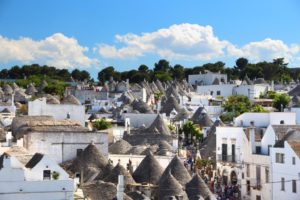
Between 1909 and 1936, trulli have been protected as historic monuments, and as a group, were inscribed on the World Heritage List in 1996 as an example of human settlement that retains its original form to a remarkable extent. The greatest threat to the survival of trulli is abandonment, due mostly to the decline in residential use.
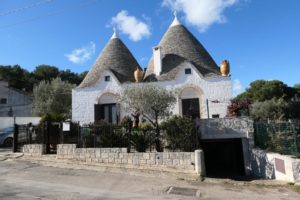
The cost of adaptive re-use to other uses such as tourist accommodation or retail premises has often led to the disregard of building regulations and conservation standards, e.g., in order to add more doors and windows, where the authenticity of the trulli is either lost or degraded. As a consequence of these obstacles, there are quite a number of “reproduction” trulli.
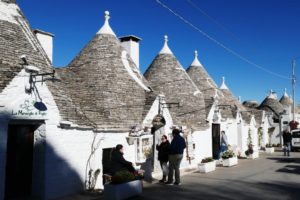
The many trulli in Alberobello are mostly grouped close together along narrow, winding streets. They now serve as little shops, usually selling a variety of themed tourist merchandise—think hand-towels and t-shirts embroidered with trulli motifs, and yes, even trulli snowdomes! A number of others have been converted into little cafes and vacation rental apartments.
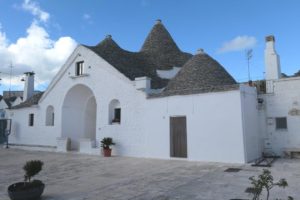
Don’t miss visiting Trullo Sovrano, which is the only two-storey trullo in Alberobello, and thanks to this status, has become a tourist attraction in its own right. It’s now the town’s heritage museum.
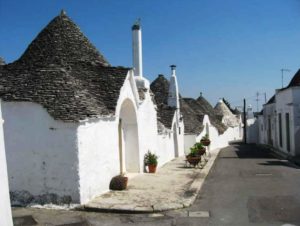
Alberobello is made up of two main communities where you can see trulli and they are both very close to each other. The first and most historic area is called Rione Monti, which has the oldest and largest concentration of trulli, numbering over 1,000. It’s also the most picturesque of the two areas, which means it is the most popular with tourists and it’s where most of the organised groups are taken. On another hill on the other side of the main road, is Aja Piccola. The area is slightly smaller, but very few of the structures have been turned into shops or restaurants. Walking through this area, you’ll hardly see any visitors and you’ll be able to get a much better feel for what this kind of community feels like for the locals.
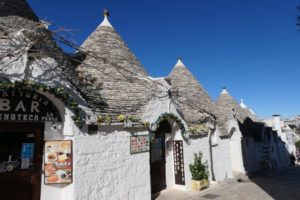
However, the main delight of Alberobello is simply wandering around the pretty little town and letting your feet guide you where they may. The best time to explore the town is earlier in the day and mid-week if possible. As you’d expect, during the height of summer in July and August, the town is absolutely crowded with visitors.
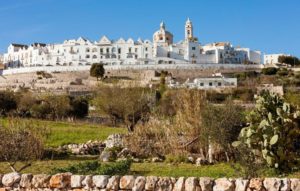
About 9 kms S.W. of Alberobello, heading back towards Ostuni, is the little town of Locorotondo. Perched on a hilltop of the Murge Plateau, this white-washed town is one of the prettiest in Puglia, with a proudly conserved, easily-walkable centre and a calm, easy-going atmosphere. Its dazzling white appearance and panoramic position recalls Ostuni, and although it’s so close to Alberobello, it doesn’t have any trulli in the town itself, but instead, has plenty of cummerse—narrow, rectangular town houses with very steep stairs leading up to the living floor level and pointed gable roofs, that someone has suggested seems to be reminiscent of a northern European, perhaps Baltic, architecture.
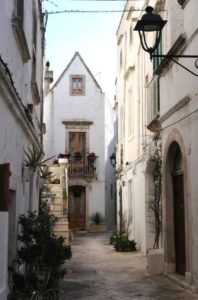
Yet although these simple, angular buildings predominate, the town is “rotund”, as its name suggests, with a circular street pattern and surrounded by its old protective walls that curve around the contours of the hill. The road that follows the wall offers wonderful views over the countryside below: a quilt of vineyards, verdant olive groves, trulli, and dry-stone walls. It’s no wonder that Locorotondo is described as the “balcony of the Valle d’Itria”.
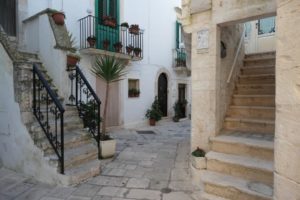
There are two original gates that give access to the town’s gently winding streets leading up to the central piazza. The narrow streets take you up past an occasional baroque palazzo and the narrow, white cummerse, where window boxes filled with vibrantly-coloured flowers, especially red geraniums, hang from cast iron balconies.
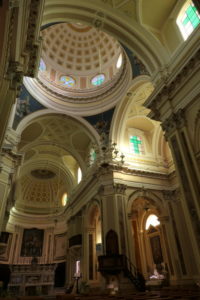
There’s an early 19th century Chiesa Madre dedicated to St George, a fine Romanesque Church of the Madonna della Greca, and most especially a small jewel, the Church of San Nicola di Myra, built around 1660, which is barely visible among the cummerse surrounding it.
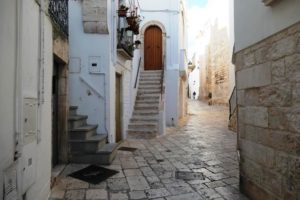
There are many alfresco bars and little restaurants where the visitor can rest and sample the local white wine, made from Bianco D’Alessano and Verdeca grapes grown nearby and made in the Cantina Sociale. In summer, most wineries offer wine tasting in their vineyard.

It’s also an opportunity to try Locorotondo’s specialities, a freshly made pasta incorporating pecorino cheese and finely chopped parsley, and cooked in a wholesome turkey broth. Alternatively, try its delicious bombettes, which are roasted pork rolls filled with cheese.
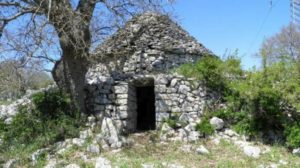
It seemed to us that most guides to Puglia tend to concentrate on the more obvious sights such as Alberobello, but we found in Locorotondo a town full of life, charm and atmosphere, and in our view, unmissable on a visit to the region. A bonus is that just 7 kms, heading north out of Locorotondo in the direction of San Marco, is the oldest trullo in Valle D’Itria, the Trullo Marziolla. The construction date as shown on the entrance architrave is 1559. The trullo is located on private property, but if you’re interested in seeing this piece of unique local history, ask the tourist office in Locorotondo’s Via Morelli about taking a guided tour.
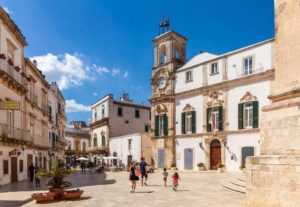
A visit to the Valle d’Itria would not be complete without a visit to Martina Franca, just 6 kms south of Locorotondo, and 24 kms from Ostuni. Larger than Alberobello or Locorotondo, Martina Franca has long been the commercial centre of the area, ever since Philip of Anjou granted it tax-free status and various other privileges in 1310. Due to its importance and the new-found wealth that flowed into the town, elegant palazzi—at least 20 of note—and around 15 churches began to spring up throughout the historic centre.
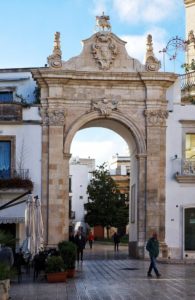
Until the reunification of Italy in 1861, Martina Franca was a fully walled town, with 24 towers and four gates. As it evolved to cater to modern requirements, some of these towers were demolished, and other access roads punched into the walls. However, the 4 Renaissance and Baroque gates still exist, effectively delineating the old town from the more modern 19th century part—which also has some fine buildings and a pleasant, shady park.
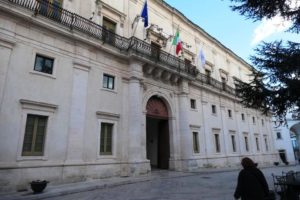
Opposite the park is the wide, tree-lined expanse of Piazza XX Settembre, which leads through the Porta di Santo Stefano (one of the 4 gates), into Piazza Roma, the location of the impressive Palazzo Ducale, built in 1668. This Palazzo served as the seat of government and today it is still the office of the civic government of Martina Franca.
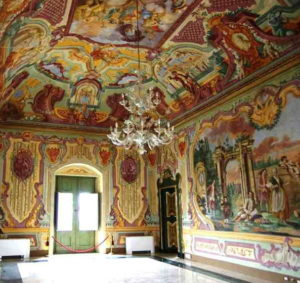
Pop inside to see the magnificent stone staircase leading up to the grand rooms on the first floor with their frescoes and décor, currently under restoration.
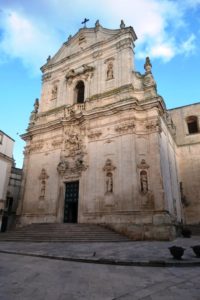
A short walk from here is the town’s most beautiful spot, the Piazza Plebiscito, the true heart of the town, and the site of its most important building, the magnificent 18th century Basilica di San Martino, with its very fine Baroque façade.
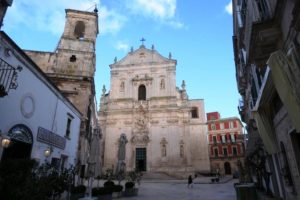
Probably the most impressive church in the Valle d’Itria, the Basilica in the centro storico is unmissable. Its exquisite Baroque façade towering over the Piazza will draw you inside where you’ll find a light and airy interior, beautiful marble columns, a grand, very ornate altar, and fine artworks in the various side chapels.
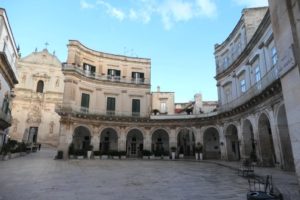
A few hundred metres from this spot is the lovely Piazza Maria Immacolata, also known as Piazza dei Portici, where you will find a grandiose, semi-circular building with arcades, Baroque buildings with wrought iron balconies filled with flowers, and cafes and restaurants everywhere you look. The local speciality is a sort of cured ham, called capocollo, making it the perfect filling for a quick lunchtime panini or a tasty appetiser with a glass of the local wine.

Just outside the town’s centro storico, that the locals call Lama, on via Pergolesi is a belvedere, affording great views over the trulli-speckled Valle d’Itria. If you visit in the spring or summer months however, the views may be partially obstructed by the many trees planted across the valley. One attraction though for music lovers at that time of year is the annual Valle d’Itria Festival, one of the main classical music and opera festivals in Italy, held from the middle of July to the beginning of August. One of the venues for this series is the Palazzo Ducale.
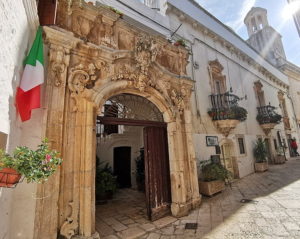
A few days exploring the Valle d’Itria is one of the most rewarding experiences of a visit to Puglia. Visually, it’s unlike any other region of Italy, especially since much of its architecture seems more reminiscent of the Greek islands. Firstly of course are the trulli, unique to the region, but also simply seeing a way of life where little has changed in centuries, and where the locals still depend on locally-grown produce, so food lovers will not be left wanting!


Nadine Connor
Fascinating, as always – however, I’m not sure about
pork filled with cheese.
Cheryl Brooks
Hi Nadine,
Thanks, as always, for warm words of encouragement! Yes, agree about the cheese & pork combo. We saw a dish of this pass us by in a restaurant, and I must say, it smelled delicious. I didn’t find out exactly what sort of cheese i.e, a heavy, dense cheese, or something lighter such as a ricotta perhaps? I’ve never seen this dish outside of Puglia, so perhaps next visit??
Diane Hogan
My favourite armchair travel read! Always very inspiring and so engaging with the history and culture of the places you visit and the pork dish looks yummy!
Thank you, once again , Cheryl.
Cheryl Brooks
Hi Diane,
Lovely to hear from you, and so delighted that you enjoy the topics I try and cover. I wish I had tried the pork dish. I saw it a couple of times passing by on other diners’ plates, and couldn’t identify it at first from the menu, as it’s a dialect word. I’ve not seen it anywhere else in Italy, even with another name. Anyway, it’s always good to have something stored up for a future visit!